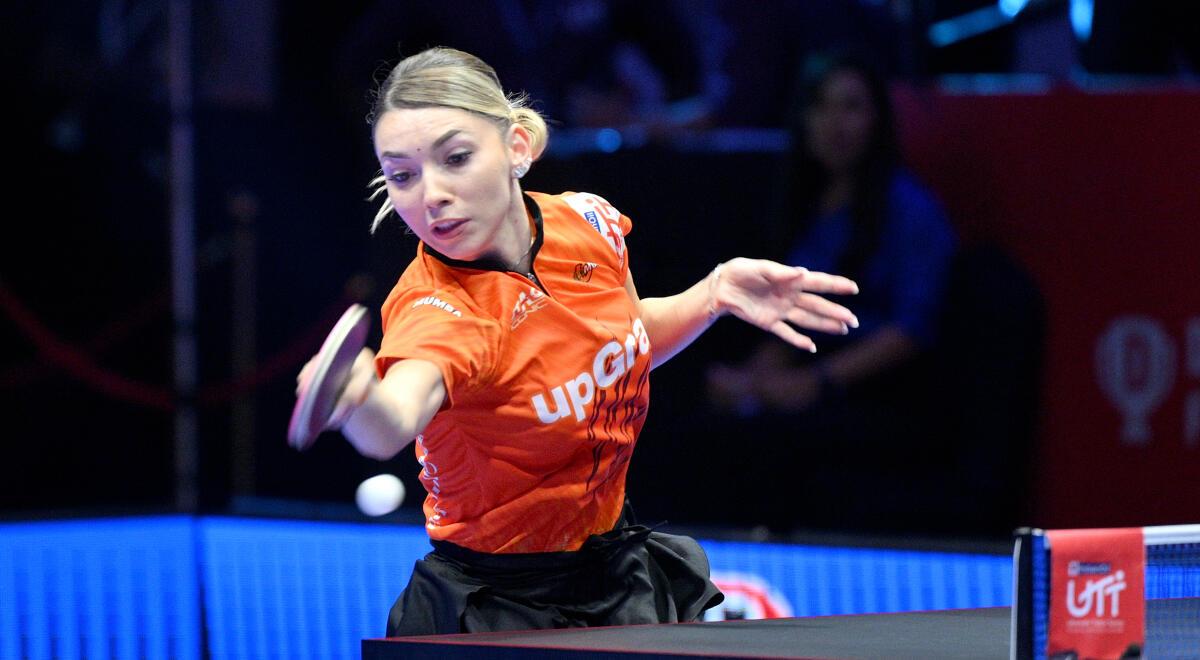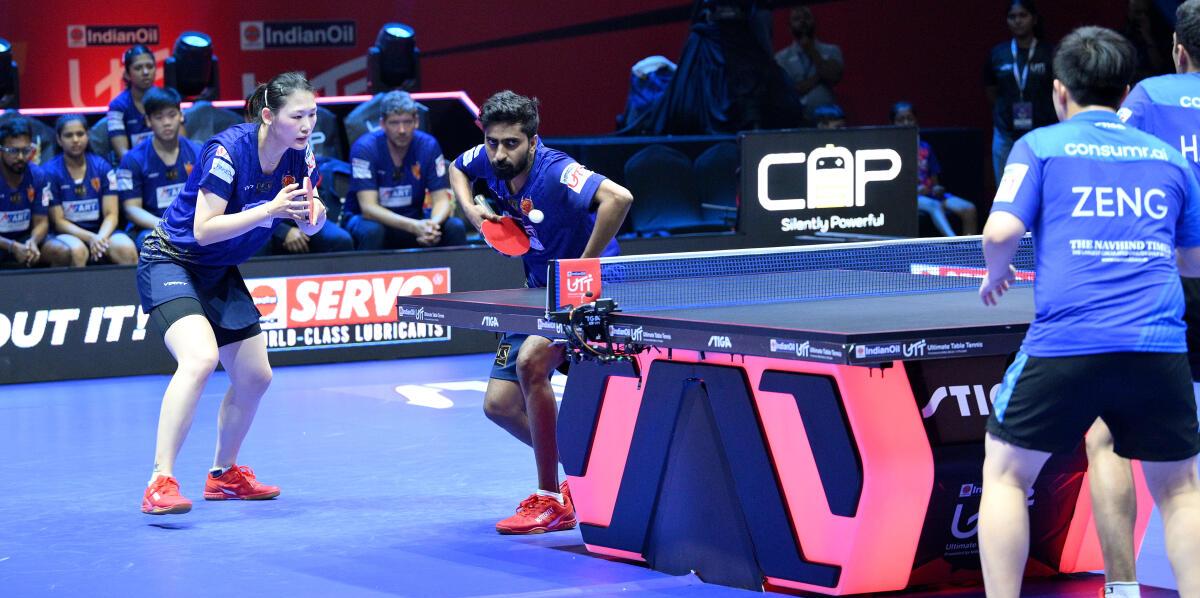The broadcast equipment was boxed up. The chairs were covered and stacked. The centre of attention — the nine-feet-long, five-feet-wide, two-and-a-half-feet-high table — was disassembled. As the clock approached midnight on June 15, the indoor stadium at the EKA Arena in Ahmedabad was on the verge of complete dismantling.
For 16 days, the temporary venue had hosted the sixth season of the Ultimate Table Tennis (UTT) league, which ended with the crowning of a new champion, U Mumba, after its 8-4 win over Jaipur Patriots in a summit clash between two first-time finalists.
The franchise-based league, staged under the aegis of the Table Tennis Federation of India (TTFI) and promoted by Niraj Bajaj and Vita Dani, had previously been held in Mumbai, Pune, New Delhi, Kolkata and Chennai. Ahmedabad’s selection as the latest host served two purposes — reaching a new live audience and furthering the city’s emergence as a hub for Olympic sports, particularly in the context of India’s bid for the 2036 Summer Games.
In the previous season, held at the Jawaharlal Nehru Indoor Stadium in Chennai after the Paris Olympics, the majority of the 2,000 available seats were empty on most matchdays. In Ahmedabad, the capacity was halved for a more intimate setting. The cheapest ticket was priced at Rs 49, while premium hospitality ones went up to Rs 1,999.
Corporate tournaments were held as part of a pre-event local activation campaign, but as with UTT 5, there were days when the EKA Arena looked sparsely populated.
The recent tension between India and Pakistan, following the terror attack in Pahalgam, led to a rescheduling of the Indian Premier League (IPL) playoffs — one of the biggest events in Indian sport. The Eliminator (June 1) and the IPL Final (June 3), both held in Ahmedabad, clashed with two of the first four days of UTT 6. On both days, UTT hosted single ties starting at 5pm, two-and-a-half hours before the IPL matches — but the stands were nearly empty.
From June 4 to 7, a state-ranking tournament was being held in Bhavnagar, 170 km from Ahmedabad, which reduced the chances of local players and fans attending UTT in the opening phase.
However, fixtures involving tournament debutant Kolkata ThunderBlades had a vibrant atmosphere, thanks to an enthusiastic cheering squad and dholwalas supporting the baby-blue-clad team. The co-owners — Ketan Jain and Rajat Kumar, both former national-level players — set a fan engagement template later adopted by the Patriots.
The season ended on a relatively upbeat note, with around 500 spectators attending each of the two semifinals and a near-capacity crowd present for the final.
Also, with 20 million viewers tuning in across TV and OTT platforms last season, and a broadcast deal with JioStar running until 2027, the organisers may not be overly concerned about live audience numbers and might let that aspect evolve organically.
From a talent perspective, UTT 6 featured top international names like World No. 12 Bernadette Szocs, World No. 17 Adriana Díaz, World No. 25 Quadri Aruna, World No. 34 Ricardo Walther and World No. 42 Britt Eerland. For the first time since the inaugural edition in 2017, a Chinese player — Fan Siqi — participated. She was the most valuable player at UTT’s first-ever auction in April.

World No. 12 Bernadette Szocs was one of the star attractions at this year’s UTT.
| Photo Credit:
VIJAY SONEJI
World No. 12 Bernadette Szocs was one of the star attractions at this year’s UTT.
| Photo Credit:
VIJAY SONEJI
For India, established players such as Harmeet Desai (Dempo Goa Challengers), Sreeja Akula (Jaipur Patriots), and G. Sathiyan (Dabang Delhi TTC) featured, but there were notable absentees. Ahmedabad SG Pipers’ Manika Batra was ruled out two days before the tournament due to injury. Manav Thakkar and Manush Shah — the country’s top two male paddlers and both Gujaratis — missed out due to commitments in foreign leagues. For a league built as a platform to boost Indian table tennis, their absence was a blow.
At the same time, eight Indian players made their UTT debuts, with several putting in standout performances. U Mumba’s Akash Pal, who didn’t get a game in UTT 5, justified his retention by becoming the best Indian doubles player this season. P.B. Abhinandh, a 17-year-old from Chennai and a Mumbai franchise member, shocked Olympian Izaac Quek on debut, bagged a crucial game in the semifinal against the Challengers, and secured the title-winning point in the final. Youngsters Ankur Bhattacharjee, Yashaswini Ghorpade, and Diya Chitale also strengthened their claims as rising stars. A new Under-15 event titled Dream UTT Juniors, won by the ThunderBlades, was a welcome addition.
The quality of play steadily improved. Both semifinals were tightly contested, with the second one decided on a Golden Point in the 15th and final game. In the league stage, 11 of 20 ties ended with either 8-7 or 9-6 scorelines. The semifinal qualification cut-off was 41 points — the highest in the last three seasons.

Dabang Delhi’s Maria Xiao and G. Sathiyan in action against Goa Challengers’ Zeng Jian and Harmeet Desai during UTT Season 6 in Ahmedabad.
| Photo Credit:
VIJAY SONEJI
Dabang Delhi’s Maria Xiao and G. Sathiyan in action against Goa Challengers’ Zeng Jian and Harmeet Desai during UTT Season 6 in Ahmedabad.
| Photo Credit:
VIJAY SONEJI
All eight teams fought fiercely for every point, and controversies naturally followed — over let calls, questionable service motions, and close edge-ball decisions that challenged even the keenest eyes.
“The review system was recently trialled at the ITTF World Cup and the ITTF World Championships but hasn’t been implemented fully. Hopefully, once it becomes permanent on the WTT circuit, we may see it in upcoming UTT seasons too,” said Desai.
Some coaches and players also advocated for the inclusion of one-minute timeouts, already standard on the international circuit.
John Murphy, coach of champion U Mumba, suggested a tweak to the tie format: “Instead of following the set sequence of men’s singles, women’s singles, mixed doubles, reverse men’s singles and reverse women’s singles, the team winning the toss should be allowed to choose whether to start with a male or female player. For a team like us with Bernadette Szocs, we’d want her to open the tie. It could also prevent the final singles from always being a women’s match.”
Jorg Bitzigeio, coach of the bottom-placed Stanley’s Chennai Lions, called for an end to player retentions in future auctions. “Among Indian male players, two (Desai and Sathiyan) are strong in both singles and doubles, offering more tactical options. Others are either still developing in one format or the other. These two have always been retained [Sathiyan wasn’t retained but stayed at Dabang]. It’s better if there’s no retention,” he said.
Attracting more global stars and top coaches doesn’t seem to be a concern for UTT. Indian paddlers have shown marked improvement in international results since the league’s inception in 2017 — winning 15 Commonwealth Games medals, three at the Asian Games, and seven at the Asian Championships.
But when it comes to the financial health of franchises, the picture is mixed. The league expanded from six to eight teams last year. For UTT 6, ThunderBlades replaced Bengaluru Smashers and Puneri Paltan rebranded as PBG Pune Jaguars.
“Goa have made money. Like that, if the franchises put in little effort, they’ll all break even soon,” said Dani on the morning of the final. “You may have noticed that many of these franchises now have started getting sponsors, reflected by their jerseys. That’s a sign that people believe in our model, the game and the league as a property.
“Of course, it will take a little time but we are moving in the right direction and quickly. For us, as league owners, our ROI is in how Indian table tennis does more than financials because we are not here to only make money. It is more important that as a country, we do well.”
Across six editions, there have been 16 franchises. Of these, only the Challengers has turned a profit — largely thanks to its back-to-back titles in 2023 and 2024.

